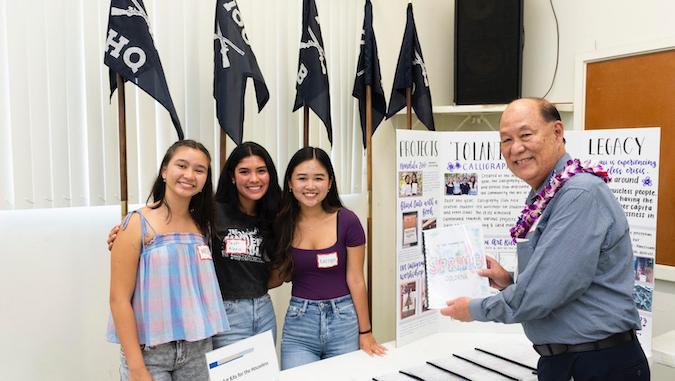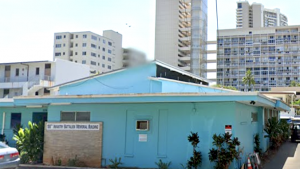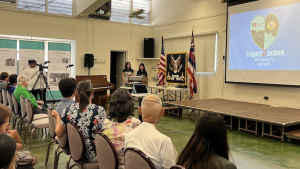
The University of Hawaiʻi at Mānoa Center on Aging and ʻIolani School have teamed up to revitalize a historic club that served as a gathering place for veterans of the legendary 100th Infantry Battalion, which originated as an all-Japanese American combat unit during World War II and later became recognized as the most decorated unit for its size and length of service in the history of the U.S. military.
For most of its existence since it was built in 1952, the unassuming one-story building long known as “Club 100” at 520 Kamoku Street was a second home for many of the Nisei (second-generation Japanese American) veterans, where they socialized with their fellow veterans, held meetings and celebrated collective holiday gatherings with their families. The camaraderie and bonds forged during the war extended into civilian life for decades.

However, as time passed, the original members of the clubhouse began to age and the veterans began to pass away. Involvement in the clubhouse waned, and the COVID-19 pandemic that forced closures of so many meeting spaces only worsened matters. The future of the clubhouse was uncertain, and steps were taken by the organization’s previous board to transfer ownership of the land and building to a mainland veterans organization.
A group of the clubhouse’s members, many of them sons and daughters of the original members, decided this was not the best direction to take and saw a different future for the clubhouse, one that had the potential for greater engagement between the clubhouse and nearby community partners.
“Initially, the 100th Infantry Battalion Veterans new board of directors wanted support in creating intergenerational programming as part of their larger mission to educate youth about the 100th,” said Christy Nishita, a gerontologist and interim director of the Center on Aging in the Thompson School of Social Work & Public Health.
Nishita teamed up with ʻIolani School’s Candice Sakuda, director of community and civic engagement, and leaders and staff at the 100th Infantry Battalion Veterans organization, to embark on an project-based learning initiative called Legacy2Action.
The partnership made sense as ʻIolani School is right across the street from the clubhouse, and the Legacy2Action project is an intergenerational activity that connects middle and high school students with adults of all ages in an effort to improve society in some way through the shared values that inspired the Nisei soldiers to serve their country during the war.
Kūpuna empowerment using Ibasho concept
The future of Hawaiʻi relies on the positive values carried forward by its youth today
—Christy Nishita
Nishita met with board members and talked about kūpuna empowerment and the Ibasho model. A Japanese word and concept, Ibasho is a set of principles to help guide elders as they take a leadership role in creating an interdependent support system, finding ways to give back to their community, and becoming change agents who help create a more inclusive and resilient community.
The Ibasho model aligned well with the board members’ interest in engaging more with the surrounding neighborhood and schools.
“They really got excited about that,” Nishita said. “And of course, adding in what we know that purpose and meaning can contribute to a longer and better quality life.”
Revitalization projects
In February, students from Oʻahu’s public and private schools gathered at the clubhouse to learn about the legacy of the Nisei soldiers and then—with assistance from clubhouse members, educators and parents—fanned out throughout the building and on the premises outside to apply their positive, youthful energy to a variety of beautification and cleaning projects. The clubhouse felt revitalized from the pre-spring cleaning––as well as a sense of re-opening after nearly three years under the cloud of a global pandemic that forced many gathering spots like this to close its doors.

Another collaboration transpired in April, when students returned to the clubhouse to share their Legacy2Action projects with parents, teachers and current clubhouse and community members.
ʻIolani School student Owen Lai worked with Nishita, his project mentor, through a needs assessment research in which he studied the potential for greater community engagement between the clubhouse and nearby community partners through qualitative interviews and surveys. Lai’s research resulted in a list of community-based solutions including intergenerational activities, field trips, sponsored competitions, expanding membership, curriculum building and more. He hopes to collect more data from different stakeholders to enhance his findings.
Many other projects designed to improve some aspects of society were described on poster boards around the clubhouse’s interior wall, with students available to expand on their research and answer questions.

Projects included the dangers of invasive seaweed species (known in Japanese as “ogo”) in Hawaiʻi‘s oceans and what can be done to mitigate the problem; an intergenerational activity kit for grandparents and elementary-aged grandchildren to learn about Japanese-American internment during WWII together; and art kits for houseless children.
“The Center on Aging is proud to partner with the 100th Infantry Battalion Veterans, helping to link generations, schools, and other organizations together in this successful Legacy2Action project-based learning experience,” said Nishita. “The future of Hawaiʻi relies on the positive values carried forward by its youth today, and if the students who participated in this year’s Legacy2Action are any indication, that future is hopeful.”

